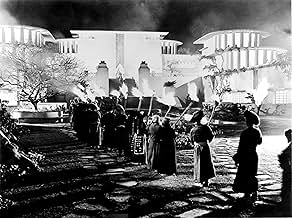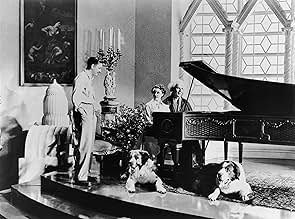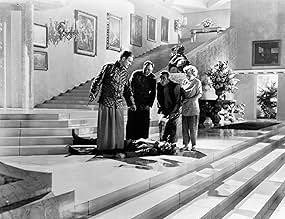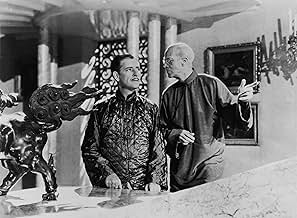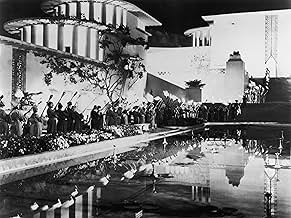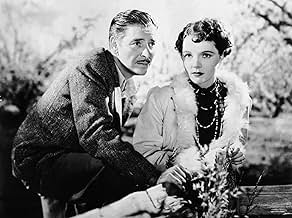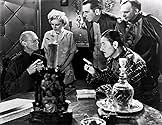IMDb रेटिंग
7.6/10
15 हज़ार
आपकी रेटिंग
अपनी भाषा में प्लॉट जोड़ेंWhen a revered diplomat's plane is diverted and crashes in the peaks of Tibet, he and the other survivors are guided to an isolated monastery at Shangri-La, where they wrestle with the invit... सभी पढ़ेंWhen a revered diplomat's plane is diverted and crashes in the peaks of Tibet, he and the other survivors are guided to an isolated monastery at Shangri-La, where they wrestle with the invitation to stay.When a revered diplomat's plane is diverted and crashes in the peaks of Tibet, he and the other survivors are guided to an isolated monastery at Shangri-La, where they wrestle with the invitation to stay.
- निर्देशक
- लेखक
- स्टार
- 2 ऑस्कर जीते
- 6 जीत और कुल 6 नामांकन
Norman Ainsley
- Embassy Club Steward
- (बिना क्रेडिट के)
Chief John Big Tree
- Porter
- (बिना क्रेडिट के)
Wyrley Birch
- Missionary
- (बिना क्रेडिट के)
Beatrice Blinn
- Passenger
- (बिना क्रेडिट के)
Hugh Buckler
- Lord Gainsford
- (बिना क्रेडिट के)
Sonny Bupp
- Boy Being Carried to Plane
- (अपुष्टिकृत)
- (बिना क्रेडिट के)
John Burton
- Wynant
- (बिना क्रेडिट के)
Tom Campbell
- Porter
- (बिना क्रेडिट के)
Matthew Carlton
- Pottery Maker
- (बिना क्रेडिट के)
फ़ीचर्ड समीक्षाएं
The second half of the 1930s saw the return of the big picture - bigger budgets, grander ideas, longer runtimes in which to tell a story. But the 30s were also a decade of highly emotional and humanist cinema, fuelled by the hardships of the great depression. Lost Horizon sees what was for the time a rare marriage between burgeoning picture scope, in what was "poverty row" studio Columbia's most expensive production to date, and poignant intimacy in the source novel by James Hilton.
Thank goodness for director Frank Capra, who seemed really able to balance this sort of thing. Capra could be a great showman, composing those beautiful iconic shots to show the magnificent Stephen Goosson art direction off to best advantage. But he also knows how to bring out a touching human story. In some places Capra's camera seems a trifle distant, and is almost voyeuristic as it peeps out through foliage or looming props. But rather than separate us from the people it is done in such a way as to give a kind of respectful distance at times of profound emotion, for example when Ronald Colman comes out of his first meeting with the High Lama. The camera hangs back, just allowing Colman's body language to convey feelings. At other times Capra will go for the opposite tack, and hold someone in a lengthy close-up. In this way we are given to just one facet a character's emotional experience, and it becomes all the more intense for that.
Of course such techniques would be nothing without a good cast. There couldn't really have been anyone better than Ronald Colman for the lead role. Now middle-aged, but still possessed with enough charm and presence to carry a movie, Colman has a slow subtlety to his movements which is nevertheless very expressive. His face, an honest smile but such sad eyes, seems to be filled with all that hope and longing that Lost Horizon is about. Sturdy character actors H.B. Warner and Thomas Mitchell give great support. It's unusual to see comedy player Edward Everett Horton in a drama like this, and comedy players in dramas could often be a sour note in 1930s pictures, but Horton is such a lovable figure and just about close enough to reality to pull it off. The only disappointing performance is that of John Howard, who is overwrought and hammy, but even this works in a way as it makes his antagonistic character seem to be the one who is out of place.
Lost Horizon is indeed a wondrous picture, and one that fulfils its mission statement of being both sweeping and soul-stirring. It appears that Capra, always out for glory, was out to make his second Academy Award Best Picture. But history was to repeat itself. In 1933 he had had his first go at a potential Oscar-winner with The Bitter Tea of General Yen, only for that picture to be ignored and the more modest It Happened One Night to win the plaudits the following year. Lost Horizon won two technical Oscars, but bombed at the box office, but in 1938 the down-to-earth comedy drama You Can't Take it with You topped the box office and won Best Pic.
Lost Horizon was in no way worthy of such a dismissal, and is indeed a bit better than You Can't Take it with You. It was perhaps more than anything a case of bad timing. Audiences were only just starting to get used to two-hour-plus runtimes, especially for movies with such unconventional themes. If you look at contemporary trailers and taglines, you can see it was being pitched as some kind of earth-shattering spectacular, whereas it is more in the nature of an epic drama. For later releases the movie was edited down to as little as 92 minutes. Fortunately, we now have a restored version. The additional material that has been reconstructed is vital for giving depth, not only to the characters, but also to the setting of Shangri-La itself. With hindsight, we can look back on Lost Horizon as a work of real cinematic beauty.
Thank goodness for director Frank Capra, who seemed really able to balance this sort of thing. Capra could be a great showman, composing those beautiful iconic shots to show the magnificent Stephen Goosson art direction off to best advantage. But he also knows how to bring out a touching human story. In some places Capra's camera seems a trifle distant, and is almost voyeuristic as it peeps out through foliage or looming props. But rather than separate us from the people it is done in such a way as to give a kind of respectful distance at times of profound emotion, for example when Ronald Colman comes out of his first meeting with the High Lama. The camera hangs back, just allowing Colman's body language to convey feelings. At other times Capra will go for the opposite tack, and hold someone in a lengthy close-up. In this way we are given to just one facet a character's emotional experience, and it becomes all the more intense for that.
Of course such techniques would be nothing without a good cast. There couldn't really have been anyone better than Ronald Colman for the lead role. Now middle-aged, but still possessed with enough charm and presence to carry a movie, Colman has a slow subtlety to his movements which is nevertheless very expressive. His face, an honest smile but such sad eyes, seems to be filled with all that hope and longing that Lost Horizon is about. Sturdy character actors H.B. Warner and Thomas Mitchell give great support. It's unusual to see comedy player Edward Everett Horton in a drama like this, and comedy players in dramas could often be a sour note in 1930s pictures, but Horton is such a lovable figure and just about close enough to reality to pull it off. The only disappointing performance is that of John Howard, who is overwrought and hammy, but even this works in a way as it makes his antagonistic character seem to be the one who is out of place.
Lost Horizon is indeed a wondrous picture, and one that fulfils its mission statement of being both sweeping and soul-stirring. It appears that Capra, always out for glory, was out to make his second Academy Award Best Picture. But history was to repeat itself. In 1933 he had had his first go at a potential Oscar-winner with The Bitter Tea of General Yen, only for that picture to be ignored and the more modest It Happened One Night to win the plaudits the following year. Lost Horizon won two technical Oscars, but bombed at the box office, but in 1938 the down-to-earth comedy drama You Can't Take it with You topped the box office and won Best Pic.
Lost Horizon was in no way worthy of such a dismissal, and is indeed a bit better than You Can't Take it with You. It was perhaps more than anything a case of bad timing. Audiences were only just starting to get used to two-hour-plus runtimes, especially for movies with such unconventional themes. If you look at contemporary trailers and taglines, you can see it was being pitched as some kind of earth-shattering spectacular, whereas it is more in the nature of an epic drama. For later releases the movie was edited down to as little as 92 minutes. Fortunately, we now have a restored version. The additional material that has been reconstructed is vital for giving depth, not only to the characters, but also to the setting of Shangri-La itself. With hindsight, we can look back on Lost Horizon as a work of real cinematic beauty.
As of this writing "The Lost Horizon" is about to be released on blu-ray in its all new 4k restoration. The film (as well the remake) had major cuts made prior to there general release! Eventually both have footage lost or destroyed so a full directors cut of either film will never happen. Both film were box office failures on their initial releases. (The Remake is also not as bad as some people think)
In 1942, the film was re-released as The Lost Horizon of Shangri-La. A lengthy drunken speech delivered by Robert Conway, in which he cynically mocks war and diplomacy, had already been deleted in the general release version. Capra felt the film made no sense without the scene, and in later years film critic Leslie Halliwell described the missing 12 minutes as "vital". They were restored years later.
In 1952, a 92-minute version of the film was released. It aimed to downplay features of the utopia that suggested Communist ideals, a sensitive point after a Civil War in China resulted in the ascension of Mao Zedong's Communist Party in that country in 1949.
In 1973, the AFI initiated a restoration of the film. The project was undertaken by the UCLA Film and Television Archive and Columbia Pictures and took 13 years to complete. Although all 132 minutes of the original soundtrack were recovered, only 125 minutes of film could be found, so the seven minutes of missing film footage were replaced with a combination of publicity photos of the actors in costume taken during filming and still frames depicting the missing scenes.
This was also a device that Robert Harver did for his restoration of "A STAR IS BORN". That film had 30 minutes edited. Almost 30 years later he found most of the lost footage but when he did not have footage for the deleted scenes he also used stills.
In 2013, digital restoration of the film was done by Sony Colorworks. It was frame-by-frame restored at Prasad Corporation to remove dirt, tears, scratches and other artifacts.
This restoration I hope is better than the last one. Because of the deleted footage that was re-inserted back into the film was from different sources. The picture quality changes through out the film and that is distracting. The still sequences come off better!
For the film itself it is a joy to watch. It is a marvel. You so desperately want "Shangri-La" to exist. The story is a tad slow here and there but it is still a classic film that in general will hold your attention.
The film (When it was made) was a modern day look at the world we were living in! It is 1935. Before returning to England to become the new Foreign Secretary, writer, soldier, and diplomat Robert Conway (Ronald Colman) has one last task in China: to rescue 90 white Westerners in the city of Baskul. He flies out with the last few evacuees, just ahead of armed revolutionaries.
Unbeknownst to the passengers, the pilot has been replaced and their aircraft hijacked. It eventually runs out of fuel and crashes deep in the Himalayan Mountains, killing their abductor. The group is rescued by Chang (H.B. Warner) and his men and taken to Shangri-La, an idyllic valley sheltered from the bitter cold. The contented inhabitants are led by the mysterious High Lama (Sam Jaffe).
Initially anxious to return to civilization, most of the newcomers grow to love Shangri-La, including paleontologist Alexander Lovett (Edward Everett Horton), swindler Henry Barnard (Thomas Mitchell), and bitter, terminally-ill Gloria Stone (Isabel Jewell), who miraculously seems to be recovering. Conway is particularly enchanted, especially when he meets Sondra (Jane Wyatt), who has grown up in Shangri-La. However, Conway's younger brother George (John Howard), and Maria (Margo), another beautiful young woman they find there, are determined to leave.
Frank Capra's production design seems to have influenced "The Wizard of Oz" which was made 2 years later. There is certain sequences that "oz" echos.
In 1942, the film was re-released as The Lost Horizon of Shangri-La. A lengthy drunken speech delivered by Robert Conway, in which he cynically mocks war and diplomacy, had already been deleted in the general release version. Capra felt the film made no sense without the scene, and in later years film critic Leslie Halliwell described the missing 12 minutes as "vital". They were restored years later.
In 1952, a 92-minute version of the film was released. It aimed to downplay features of the utopia that suggested Communist ideals, a sensitive point after a Civil War in China resulted in the ascension of Mao Zedong's Communist Party in that country in 1949.
In 1973, the AFI initiated a restoration of the film. The project was undertaken by the UCLA Film and Television Archive and Columbia Pictures and took 13 years to complete. Although all 132 minutes of the original soundtrack were recovered, only 125 minutes of film could be found, so the seven minutes of missing film footage were replaced with a combination of publicity photos of the actors in costume taken during filming and still frames depicting the missing scenes.
This was also a device that Robert Harver did for his restoration of "A STAR IS BORN". That film had 30 minutes edited. Almost 30 years later he found most of the lost footage but when he did not have footage for the deleted scenes he also used stills.
In 2013, digital restoration of the film was done by Sony Colorworks. It was frame-by-frame restored at Prasad Corporation to remove dirt, tears, scratches and other artifacts.
This restoration I hope is better than the last one. Because of the deleted footage that was re-inserted back into the film was from different sources. The picture quality changes through out the film and that is distracting. The still sequences come off better!
For the film itself it is a joy to watch. It is a marvel. You so desperately want "Shangri-La" to exist. The story is a tad slow here and there but it is still a classic film that in general will hold your attention.
The film (When it was made) was a modern day look at the world we were living in! It is 1935. Before returning to England to become the new Foreign Secretary, writer, soldier, and diplomat Robert Conway (Ronald Colman) has one last task in China: to rescue 90 white Westerners in the city of Baskul. He flies out with the last few evacuees, just ahead of armed revolutionaries.
Unbeknownst to the passengers, the pilot has been replaced and their aircraft hijacked. It eventually runs out of fuel and crashes deep in the Himalayan Mountains, killing their abductor. The group is rescued by Chang (H.B. Warner) and his men and taken to Shangri-La, an idyllic valley sheltered from the bitter cold. The contented inhabitants are led by the mysterious High Lama (Sam Jaffe).
Initially anxious to return to civilization, most of the newcomers grow to love Shangri-La, including paleontologist Alexander Lovett (Edward Everett Horton), swindler Henry Barnard (Thomas Mitchell), and bitter, terminally-ill Gloria Stone (Isabel Jewell), who miraculously seems to be recovering. Conway is particularly enchanted, especially when he meets Sondra (Jane Wyatt), who has grown up in Shangri-La. However, Conway's younger brother George (John Howard), and Maria (Margo), another beautiful young woman they find there, are determined to leave.
Frank Capra's production design seems to have influenced "The Wizard of Oz" which was made 2 years later. There is certain sequences that "oz" echos.
"I believe it because I want to believe it". This one line speaks volumes about what the movie (and the original novel) was trying to say. The concept of Shangri-La, a place where people work and live in peaceful harmony, is as relevant today as it was in the post-World War I era that James Hilton wrote 'Lost Horizon', where the world was still in turmoil following a devastating war and another was on its way.
In these days of war, humanitarian devastation and disease, how many people are there who dream of getting away from it all and living out their lives in a remote paradise just like Shangri-La? The High Lama's words to Conway resonate strongly even today.
"Look at the world today. Is there anything more pitiful? What madness there is! What blindness! What unintelligent leadership! A scurrying mass of bewildered humanity, crashing headlong against each other, propelled by an orgy of greed and brutality." On a more cinematographic note, the movie is visually stunning in an age before CGI and astronomical budgets. The beauty of Shangri-La, the stunning mountain landscapes and the overall settings of the movie make us believe that such a wonderful place can exist. All the actors are commendable in their portrayals (though some characters are different to those in the original novel) and their interaction with each other add a real sparkle to the movie.
'Lost Horizon' is a beautiful adaptation of James Hilton's masterpiece and captures the very feeling of the novel and I would highly recommend it to anyone who has ever dreamed of escaping from the hectic world in which we live.
In these days of war, humanitarian devastation and disease, how many people are there who dream of getting away from it all and living out their lives in a remote paradise just like Shangri-La? The High Lama's words to Conway resonate strongly even today.
"Look at the world today. Is there anything more pitiful? What madness there is! What blindness! What unintelligent leadership! A scurrying mass of bewildered humanity, crashing headlong against each other, propelled by an orgy of greed and brutality." On a more cinematographic note, the movie is visually stunning in an age before CGI and astronomical budgets. The beauty of Shangri-La, the stunning mountain landscapes and the overall settings of the movie make us believe that such a wonderful place can exist. All the actors are commendable in their portrayals (though some characters are different to those in the original novel) and their interaction with each other add a real sparkle to the movie.
'Lost Horizon' is a beautiful adaptation of James Hilton's masterpiece and captures the very feeling of the novel and I would highly recommend it to anyone who has ever dreamed of escaping from the hectic world in which we live.
I watched this film for the first time as a 10 year old and its effects on my willingness to be a optimistic idealist have always been led by my memories of this hope inspiring tribute to the need for the human being to find Heaven in this life. Perhaps Lost Horizon could have been that spark that enabled me to find just that. Like all films from another era do not judge this film for its apparent imperfections, rather for what it offered the audiences of that time (1937), hope that all would be well when man would recognize that his time is always better spent broadening his horizons of understanding. Frank Capra's guides his audiences through danger and turmoil to that place which dreams are made of, when we all make the effort to make it happen.
There is an aura that seems to surround classic films made before the days of computer generated visual effects and intense marketing campaigns. It was a time when motion pictures depended on grand stories, superb performances, and great direction to catapult their success. This was exactly the case of `Lost Horizon,' a film from director Frank Copra (`It's A Wonderful Life'). With elaborate set designs, excellent performances by Ronald Colman, Jane Wyatt, John Howard, Thomas Mitchell, and Edward Everett Horton, `Lost Horizon' is a story of survival and ultimately finding a way home, that cannot be forgotten. `Lost Horizon' is a tale of five castaways who inadvertently find themselves in Shangri-La after their plane crashes in the mountains of Tibet. They are lead into the place of eternal youth, natural beauty, and free from strife by members of the region. They are treated as guests, and although they want to leave and find their way back to the world as they know it, porters are hard to find. It all leads to a notion that none of them want to admit; that they were meant to be in Shangri-La. Out of the thousands of movies that have been produced in the past 100 years, only a few afford of the privilege of remembrance. What's more, only a few seem to survive due to the nature of celluloid prints breaking down over time. A similar problem plagued `Lost Horizon,' in that after decades of worthy theatrical re-issues, the prints depreciated, with many withering away. As such, a preservation program was set in place to save copies of the film. Thanks to the works of countless individuals, this classic has been restored, to a certain degree, with some of the footage missing, replaced by still shots of the actors and recorded dialogue. From a critical standpoint, `Lost Horizon' has stood the test of time to be one of the greatest adventure classics ever produced by Hollywood. What is astonishing about this film is the attention to detail. As the film begins, a battle is taking place somewhere in China where we meet our protagonist, Bob Conway (Coleman). As the film continues, the scene changes to a scene on an airplane where our characters are trying to leave the war torn region. At one point, the crew is at a high altitude where the temperature is very cold. As such, we can see their breath in the shot as they speak. Normally, this kind of feature is ignored as the scene is short, but it adds a touch of realism that can't be denied. Incredible detail went into the creation of Shangri-La. With its large sets, beautiful costume design, the film takes on an epic proportion only rivaled by the grand designs of such Biblical epics as `Ben-Hur,' and `The Ten Commandments.' Truly, director Capra wanted to create an image that audiences would be astounded by
and he truly succeeded.
One can't help but admire the characters-they are all a bit naïve, but all intriguing in their own ways. Conway (Coleman) is a British diplomat and explorer whose fame is well deserved. His brother, George (Howard) presents a great deal of fear for the unknown Shangri-La. The characters of Henry Barnard (Mitchell) and Alexander P. Lovett (Horton) add a real sense of humor to the film. There are some minor inconsistencies in the story and various tasks that the characters try to pull off, but it's hardly worth complaining about because the film is such a treasure among other films. After 66 years, `Lost Horizon' remains far better than most of the adventure films that play in cinemas nowadays. One can only wish that they could have been present to see this in a theater during its original run. How amazing it would have been to see this epic tale of survival and the human struggle against itself back in 1937. `Lost Horizon' is indeed a remnant from the golden age of cinema. ***1/2
One can't help but admire the characters-they are all a bit naïve, but all intriguing in their own ways. Conway (Coleman) is a British diplomat and explorer whose fame is well deserved. His brother, George (Howard) presents a great deal of fear for the unknown Shangri-La. The characters of Henry Barnard (Mitchell) and Alexander P. Lovett (Horton) add a real sense of humor to the film. There are some minor inconsistencies in the story and various tasks that the characters try to pull off, but it's hardly worth complaining about because the film is such a treasure among other films. After 66 years, `Lost Horizon' remains far better than most of the adventure films that play in cinemas nowadays. One can only wish that they could have been present to see this in a theater during its original run. How amazing it would have been to see this epic tale of survival and the human struggle against itself back in 1937. `Lost Horizon' is indeed a remnant from the golden age of cinema. ***1/2
क्या आपको पता है
- ट्रिवियाThe year after this film was released the owner of a prosperous theater chain hired an architect who designed a mansion that was inspired by the Shangri-La lamasery in this film. Located in Denver, Colorado, it still exists today.
- गूफ़Echoing the words of the critic, James Agate: 'The best film I've seen for ages, but will somebody please tell me how they got the grand piano along a footpath on which only one person can walk at a time with rope and pickaxe and with a sheer drop of three thousand feet or so?'
- क्रेज़ी क्रेडिटBob Gitt of the UCLA Film & Television Archives claims the original opening sequence in 1937 had title cards "Conway has been sent to evacuate ninety white people before they're butchered in a local revolution" was changed in 1942 for a special reissue during WWII. The title cards read "before innocent Chinese people were butchered by Japanese hordes." This was to bolster propaganda against the Japanese.
- इसके अलावा अन्य वर्जनSome of the music in the restored version is dubbed into different sections than the ones in the 118 minute cut version. For example, the moment in which Robert Conway ('Ronald Colman') discovers that the High Lama is really Father Perrault i accompanied by soft music in the cut version, while in the restored version this moment is played with no music.
- कनेक्शनEdited from Stürme über dem Mont Blanc (1930)
- साउंडट्रैकWiegenlied (Lullaby) Op. 49 No. 4
(1868) (uncredited)
Composed by Johannes Brahms
English translator unknown
Sung a cappella by children at Shangri-La
टॉप पसंद
रेटिंग देने के लिए साइन-इन करें और वैयक्तिकृत सुझावों के लिए वॉचलिस्ट करें
- How long is Lost Horizon?Alexa द्वारा संचालित
- Why was Maria so anxious to leave Shangri La?
- Why is Maria so anxious to leave Shangri La?
- Is the version usually seen faithful to the director's intentions?
विवरण
बॉक्स ऑफ़िस
- बजट
- $40,00,000(अनुमानित)
- चलने की अवधि2 घंटे 12 मिनट
- रंग
- पक्ष अनुपात
- 1.37 : 1
इस पेज में योगदान दें
किसी बदलाव का सुझाव दें या अनुपलब्ध कॉन्टेंट जोड़ें



